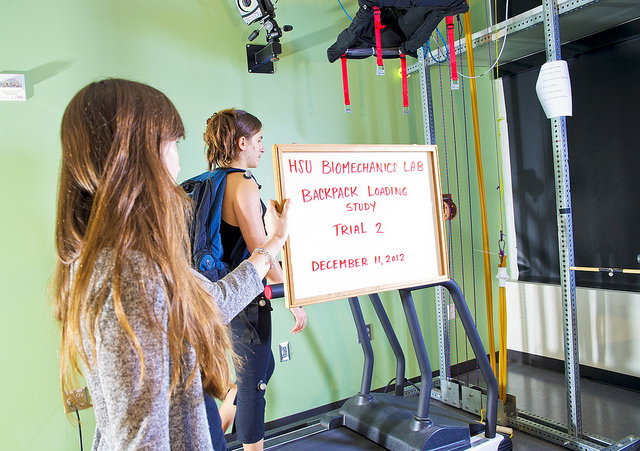Anthropology students Vincent Velasquez (’13) and Tia Meyer (’12) were interested in researching how weight-bearing loads like backpacks affect leg stride and arm swing.
“We wanted to determine the relationship between wearing a backpack and body mechanics,” says Ortega, who facilitated the experiments in HSU’s Biomechanics Lab. “Does wearing a backpack force you to take shorter, more frequent steps? Does it impede your arm swing?”
What they found is that while wearing a backpack has little to no effect on stride length or frequency, it does increase your upper and lower arm swing.

For the experiment, Velasquez and Meyer recruited 15 student volunteers. Each subject was outfitted with three marker balls: one on their shoulder, elbow and hand.
Students then walked on a treadmill with and without a backpack for three minutes at various speeds (1.6 mph, 2.9 mph and 4 mph). For each trial, they recorded the subject’s arm swing and leg motion using a video camera and motion analysis software.
The results showed that while wearing a backpack has no effect on stride length or frequency, it does increase the amount your arm swings.

Up until recently, researchers had that thought arm swing was an unnecessary movement—one of the vestiges of humans’ knuckle-walking days. But recent studies suggest that arm swing plays an important role in human locomotion by counteracting the torque—or the twisting of the spine—created by the legs while walking.
Torque has a destabilizing effect on the body, resulting in wear and tear on the spine over time. Velasquez and Meyer’s study provides important insights into injury prevention and reduction when it comes to wearing weight-bearing loads like backpacks.
It also has implications for the military, explains Ortega. “There’s a very big interest in load carriage as it relates to soldiers in the field,” Ortega says. “It’s extremely valuable in understanding fatigue over long periods of time in danger zones.”
Velasquez and Meyer first became interested in the relationship between torque and arm swing as students in Professor Mary Glenn’s Applied Evolutionary Anthropology Research class. They expanded the scope of their research with help from Ortega in the Biomechanics Lab. Last semester, they presented their research at HSU’s first annual Anthropology Symposium for undergraduate research.